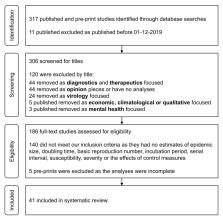- Record: found
- Abstract: found
- Article: found
A Systematic Review of COVID-19 Epidemiology Based on Current Evidence

Abstract
As the novel coronavirus (SARS-CoV-2) continues to spread rapidly across the globe, we aimed to identify and summarize the existing evidence on epidemiological characteristics of SARS-CoV-2 and the effectiveness of control measures to inform policymakers and leaders in formulating management guidelines, and to provide directions for future research. We conducted a systematic review of the published literature and preprints on the coronavirus disease (COVID-19) outbreak following predefined eligibility criteria. Of 317 research articles generated from our initial search on PubMed and preprint archives on 21 February 2020, 41 met our inclusion criteria and were included in the review. Current evidence suggests that it takes about 3-7 days for the epidemic to double in size. Of 21 estimates for the basic reproduction number ranging from 1.9 to 6.5, 13 were between 2.0 and 3.0. The incubation period was estimated to be 4-6 days, whereas the serial interval was estimated to be 4-8 days. Though the true case fatality risk is yet unknown, current model-based estimates ranged from 0.3% to 1.4% for outside China. There is an urgent need for rigorous research focusing on the mitigation efforts to minimize the impact on society.
Related collections
Most cited references48
- Record: found
- Abstract: found
- Article: not found
Clinical features of patients infected with 2019 novel coronavirus in Wuhan, China
- Record: found
- Abstract: found
- Article: not found
Clinical Characteristics of Coronavirus Disease 2019 in China
- Record: found
- Abstract: found
- Article: not found